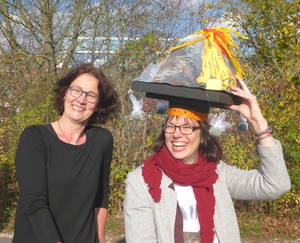PhD defense - congratulations, Julia!
2017-11-03
Julia Arndt defended her PhD on “Evaluation of active and passive sampling techniques for determination of total volatile arsenic and its speciation in volcanic gases and biogases” today.
Volatile arsenic (As) species like AsH3, MeAsH2, Me2AsH, and Me3As (“arsines”; Me = methyl group) are among other toxic trace elements known to be naturally emitted by volcanoes. So far, only few studies sample total As and its speciation on volcanoes. Therefore, the aim of the present study was to evaluate different techniques in the laboratory for sampling total atmospheric As and arsine species and to employ them on volcanic gas and biogas sampling.
In the first two studies of this thesis, moss bag monitoring was applied as field technique for emission screening of total As and other elements on several volcanoes. Studied volcanoes were the open conduit volcanoes Stromboli, Etna (both Italy), Nyiragongo (Democratic Republic of the Congo), and the hydrothermal volcanoes Vulcano (Italy) Nisyros (Greece), and Yellowstone (USA). Moss was digested in 19.5% HNO3/6% H2O2 and analyzed by inductively coupled plasma mass spectrometry (ICP MS). Monitoring emissions along a transect through the fumarolic field of Vulcano, As was revealed to be emitted as a volatile from the fumaroles with its maximum accumulation on the moss within the fumarolic field and its far downwind distribution. Its profile agreed with the volatile elements S, Sb, Se, Tl, and Bi and differed from soil-borne elements Fe, Co, and V. At the three open conduit volcanoes, volatile elements like As and S additionally correlated with Fe and Pb due to eruptive lava and ash emissions. Moss screening showed higher element accumulation rates at open conduit volcanoes than at hydrothermal volcanoes for most elements. As, S, and Se, on the contrary were higher accumulated on moss bags exposed within the fumarolic field on Vulcano compared to the crater rims of the open conduit volcanoes, which is relevant for tourist exposure to these gases.
The moss monitoring technique was evaluated for application on volcanoes revealing element accumulation patterns on the moss bags to be independent of exposure height (0.7 1.6 m), duration (3 9 weeks), and coverage of the moss bags. Moss species and shoot density, however, influence element accumulation and should therefore be normalized for comparability of different sampling areas and sites and exposure of moss triplicates is recommended.
In the third study, moss was evaluated for species preserving trapping of AsH3, MeAsH2, Me2AsH, and Me3As using batch experiments. Moss was extracted in 0.1 M HNO3 in 3% H2O2 and analyzed by IC-ICP-MS for the respective pentavalent acids of the arsines while gas analysis was done by cryotrapping cryofocussing gas chromatography electron impact mass spectrometry split atomic fluorescence spectroscopy (CT-CF-GC-EI-MS/AFS). Me2AsH and Me3As were trapped on the moss and recovered as their respective pentavalent acids while MeAsH2 was only partially trapped and inorganic As was not trapped at all. We propose the higher methylated arsines to be bound covalently to the moss surface. Consequently, moss monitoring can be employed to determine if methylarsines, besides As particles, are relevant in yet unknown As emissions.
The last study evaluated arsine species preserving sampling techniques. Needle Trap Devices (NTDs) did not trap AsH3, MeAsH2, and Me2AsH, released Me3As only partially during GC analysis, and lead to artifact formation of Me2AsCl. These results question former studies sampling environmental gases using Solid Phase Micro Extraction (SPME) equipped with the same sorption materials. Cryotrapping in dry ice only partially trapped Me2AsH and Me3As and did not trap AsH3 and MeAsH2. Tedlar bag sampling remained the best field technique for sampling volatile As, but also includes matrix gases for which arsine stability was evaluated for the first time. Arsines were stable at 5°C in the dark for 19 days in dry N2, for 11 days in 20% O2, and for 19 days in 3800 ppmV CO2 (>80% recovery for every species). In H2S, recovery of Me3As was 67% after 21 days and in 100 ppmV SO2, 40 and 11% of Me2AsH and Me3As were recovered after 21 days, respectively. To remove CO2, water vapor, and sulfur gases during sampling emissions from Vulcano and Solfatara (Italy), cooling traps and NaOH traps were employed. Inorganic AsH3 was the predominant As species recovered with concentrations of 0.5 77 ng·m 3. These concentrations suggest arsine emissions from volcanoes to be lower than estimated based on previous studies. Occurrence of exclusively AsH3 suggests microbial volatilization to be negligible at the fumaroles on Vulcano. Trapping of As on the moss bags and its inorganic recovery also suggest the (additional) presence of As particles which are formed and deposited on the mosses.
All in all, the present study shows that (a) moss monitoring is a good sampling technique for screening of total As emissions and to gain information about its origin, distribution, potential occurrence of methylated arsines, and the respective volcano’s emission activity and (b) Tedlar bag sampling proved the ideal species preserving quantitative sampling technique, even in volcanic gases, but requires elimination of these gases during sampling.


